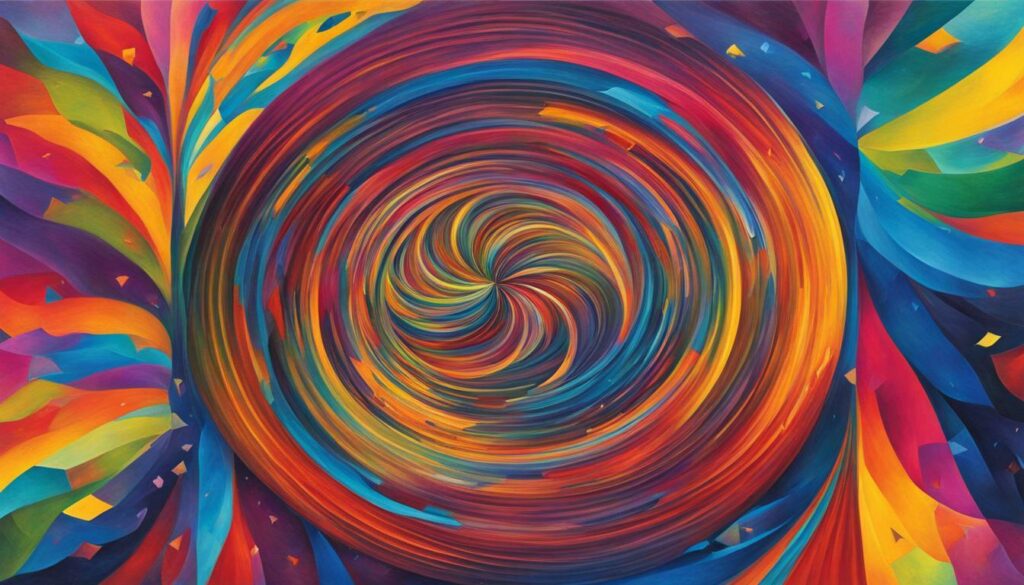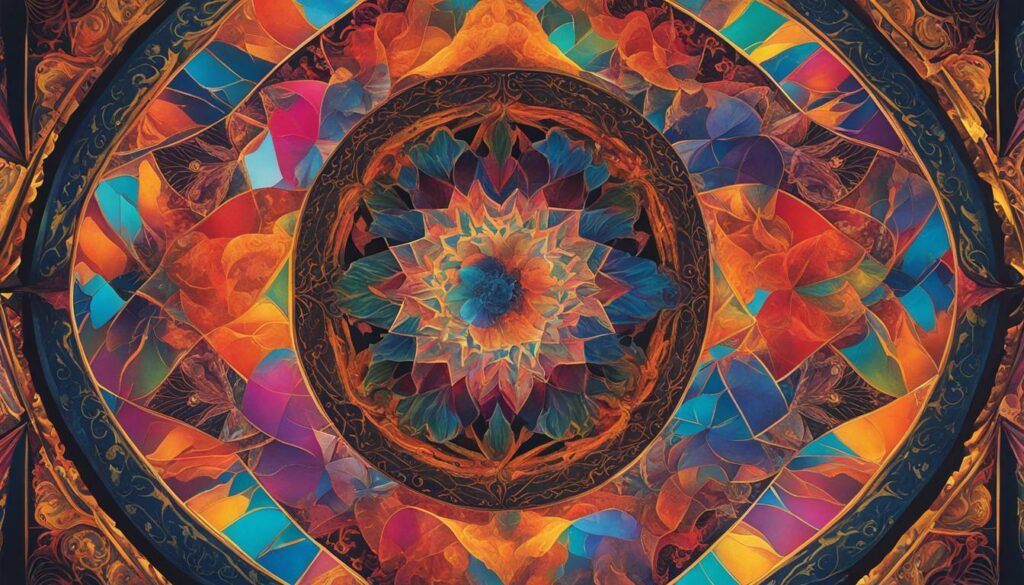Welcome to our guide on incorporating color and open-ended questions into tarot readings. In this section, we’ll explore how color can be used to ask open-ended questions that encourage exploration and deepen the spiritual journey of tarot readings. Color symbolism has powerful psychological effects that can evoke specific emotions and energies, making it a valuable tool for enhancing the interpretation of tarot cards. By incorporating color into our readings, we can invite deeper self-reflection, personal growth, and intuitive guidance. Let’s dive in!
Key Takeaways:
- Color symbolism in tarot readings can evoke specific emotions and energies, enhancing the interpretation of tarot cards.
- Incorporating color into open-ended questions encourages exploration, self-reflection, and personal growth.
- By using color and open-ended questions, we can facilitate a deeper connection with the spiritual realm and enhance the overall tarot reading experience.
Understanding the Power of Color in Tarot Readings
In tarot readings, color symbolism plays a crucial role in divination. It’s a language that expresses emotions, energy, and meaning, all of which are fundamental aspects of tarot readings. Each color has its own symbolic significance and represents an array of emotions and feelings that, when interpreted correctly, can bring greater clarity and insight to the reader and the seeker. In tarot readings, we use the color of the card as an interpretive tool and a means to connect with the divine.

The tarot deck consists of 78 cards, with each card having its own unique symbolism and meaning. The cards are divided into two categories: Major Arcana and Minor Arcana. The Major Arcana cards represent significant life events or milestones, while the Minor Arcana cards symbolize everyday occurrences or situations. In both categories, color plays a vital role in interpreting the card’s meanings.
The colors present in tarot readings signify different emotions and energies. For example, red is associated with passion, love, and strength, while blue represents tranquility, calmness, and emotional stability. Green symbolizes growth, balance, and nature, while yellow is associated with positivity, optimism, and intellectual stimulation.
Understanding the meanings and symbolism of the colors in the tarot deck is crucial for any tarot reader seeking to provide accurate and meaningful readings. It provides the reader with a deeper understanding of the messages conveyed by the cards and offers intuitive guidance to the seeker.
Incorporating color into open-ended questions
One way to use color as a tool for asking open-ended questions in tarot readings is to focus on a specific color that is prevalent in the tarot cards. For example, if a lot of green appears in the reading, we might ask questions about growth, abundance, or harmony. Similarly, if a lot of red appears, we might ask about passion, desire, or conflict.
Another approach is to ask questions that are less specific to individual colors but still incorporate color symbolism. For example, we could ask questions like, “What does this spread reveal about my emotional state?” or “What aspects of my life are calling for greater balance?” These questions invite exploration and reflection while still incorporating the powerful symbolism of color.
When formulating open-ended questions that incorporate color, it’s important to avoid leading or suggestive language. Instead, try to keep the questions as open-ended as possible, allowing the seeker to delve deeper into their own intuitive insights and personal experiences. Remember, the goal is to facilitate self-reflection and personal growth, not to impose our own interpretations onto the cards or the seeker.

Incorporating color into open-ended questions can be an effective way to enhance the spiritual journey of tarot readings. By utilizing color symbolism and inviting deeper exploration, we can facilitate intuitive insights and gain a broader understanding of the messages conveyed by the tarot cards. In the next section, we’ll explore the art of formulating open-ended questions and provide tips on how to phrase them effectively to encourage exploration and insight.
The Art of Formulating Open-Ended Questions
Now that we understand the power of open-ended questions in tarot readings, let’s explore the art of phrasing them effectively to encourage intuitive guidance and personal growth.
First, it’s important to avoid closed-ended questions that elicit yes or no responses. Instead, focus on questions that invite exploration and reflection. For example, rather than asking “Will I find true love?” try “What can I do to attract loving and fulfilling relationships?”
Second, try to phrase your questions in a way that encourages the seeker to take responsibility for their actions and choices. Questions that begin with “How can I” or “What steps can I take” empower the seeker to take action and cultivate their own intuitive guidance.
Finally, consider incorporating color symbolism into your open-ended questions. For example, if you’re using the tarot card “The Fool,” you could ask “What area of my life could benefit from more spontaneity and adventure, represented by the color yellow?”
Remember, the art of formulating open-ended questions takes practice. Don’t be afraid to experiment and see what works best for you and your clients. With time and experience, you’ll develop a confident and effective approach to intuitive guidance through tarot readings.

Exploring color symbolism in tarot spreads
When it comes to tarot readings, the layout of the cards can be just as important as the cards themselves. Tarot spreads offer a framework for understanding the messages of the cards and can provide valuable insights into specific areas of our lives. When incorporating color symbolism into tarot spreads, we can enhance the spiritual insights gained from the reading.
For example, in a love and relationship tarot spread, we can use pink and red cards to represent passion and romance. Placing these colors in specific positions within the spread can provide guidance on how to overcome current obstacles or tap into deeper levels of emotional connection.
Similarly, in a career-focused tarot spread, incorporating green cards to represent growth and prosperity can provide insights into achieving professional goals or identifying new opportunities. Using the symbolism of color in this way allows for a deeper exploration of the messages conveyed by the tarot cards within the context of the spread.

By using color symbolism in tarot spreads, we can unlock hidden meanings and gain a deeper understanding of the overall spiritual message of the reading. Whether we’re seeking guidance on love and relationships, career and finances, or other areas of our lives, incorporating color into our tarot readings can provide valuable insights and facilitate a stronger connection to the divine.
Case studies: Applying color and open-ended questions in tarot readings
In this section, we will showcase how the incorporation of color and open-ended questions can enhance tarot readings. By utilizing these techniques, we can provide more personalized and meaningful guidance for our clients as we help them navigate their spiritual journeys.
The Power of Color
During a recent tarot reading, a client was struggling with feelings of anxiety and uncertainty about their future. As we shuffled the deck, I asked them to focus on their emotions and select a card that spoke to them. The card they chose was the Six of Swords, which typically signifies moving on from a difficult situation.
To delve deeper into the meaning behind this card, I asked the client to focus on the colors present in the illustration. The shades of blue in the water and the sky symbolize calmness and stability, while the cloudy foreground suggests uncertainty. By exploring the different colors present in the card, we were able to expand upon its meaning and provide more nuanced guidance for the client.
Formulating Open-Ended Questions
Asking open-ended questions during a tarot reading can encourage deeper introspection and self-reflection. For example, instead of asking “Will I get the job I applied for?” we might ask, “What can I do to ensure success in my job search?” This type of question allows for a broader exploration of the seeker’s mindset and motivations.
In a recent reading, a client was seeking advice on a strained relationship with a family member. We asked open-ended questions like “What does forgiveness look like to you?” and “How can you find common ground with this person?” By focusing on these broader questions, we were able to explore the underlying emotions and motivations behind the client’s struggle, ultimately providing a more meaningful and insightful reading.
Color Symbolism in Tarot Spreads
When designing a tarot spread, we can incorporate color symbolism to add additional layers of meaning to the cards. For example, in a spread focused on self-reflection and personal growth, we might assign green to represent growth and renewal, blue to represent calmness and clarity, and yellow to represent creativity and inspiration.
This type of color assignment can be particularly effective in readings focused on spiritual growth and exploration. By incorporating colors that resonate with the client’s energy and intentions, we can provide more meaningful guidance and insights.

Overall, incorporating color and open-ended questions in tarot readings can enhance the seeker’s experience and provide deeper insight and guidance. By utilizing these techniques, we can facilitate spiritual growth, self-reflection, and a better understanding of the messages conveyed by the cards.
Conclusion
By incorporating color and open-ended questions into tarot readings, we can unlock hidden meanings, facilitate intuitive guidance, and promote personal growth and self-reflection. These techniques can help us to deepen our connection with the divine, enhance our spiritual journey, and gain a broader understanding of the messages conveyed by the tarot cards.
Through this article, we have explored the significance of color symbolism in tarot readings, as well as the art of formulating open-ended questions. We have discussed how color can be incorporated into tarot spreads, and showcased real-life examples of how these techniques can be applied in practice.
We hope that this article has inspired you to explore the power of color and open-ended questions in your own tarot readings. By using these techniques, you can gain deeper insights into yourself and the world around you, and embark on an enriching journey of personal growth and spiritual discovery.
FAQ
Q: How can color be used to ask open-ended questions in tarot readings?
A: Color can be incorporated into tarot readings as a way to ask open-ended questions by utilizing color symbolism and its psychological effects. By exploring different colors and their meanings, readers can invite deeper exploration and enhance the spiritual journey of tarot readings.
Q: What is the significance of color symbolism in tarot readings?
A: Color symbolism plays a powerful role in tarot readings. Different colors can evoke specific emotions, energies, and meanings, providing greater insight and intuitive guidance for both the reader and seeker. Understanding and interpreting color symbolism can enrich the tarot reading experience.
Q: How can color be incorporated into open-ended questions during tarot readings?
A: There are various techniques for incorporating color into open-ended questions during tarot readings. By using color as a starting point for exploration, readers can encourage self-reflection, personal growth, and a broader understanding of the messages conveyed by the tarot cards.
Q: What is the art of formulating open-ended questions in tarot readings?
A: The art of formulating open-ended questions involves crafting inquiries that encourage exploration, insight, and spiritual growth. By phrasing questions effectively, readers can create a space for deep reflection and intuitive guidance, allowing for a more profound tarot reading experience.
Q: How can color symbolism enhance tarot spreads?
A: Color symbolism can be incorporated into different positions within a tarot spread to enhance the interpretation of the cards. By using specific colors in specific positions, readers can gain deeper spiritual insights and facilitate a stronger connection with the divine during tarot readings.
Q: Can you provide examples of applying color and open-ended questions in tarot readings?
A: Yes, in this section, we will showcase real-life case studies that demonstrate the practical application of color and open-ended questions in tarot readings. These examples will highlight the effectiveness of using color symbolism and open-ended inquiries to unlock hidden meanings and facilitate intuitive guidance.

